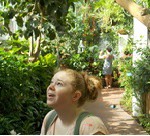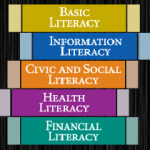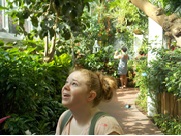
Sarah Applegate, Currently Reading: The Autobiography of Martin Luther King, Jr., edited by Clayborne Carson
by Sarah Applegate
Youth Services Manager
Coyle Free Library
A few years ago, during Summer Reading Club, I ran a session of teen programs revolving around the Disney/Pixar movies. The programs were based on a theory I read online. I used the “Fizz, Boom, Read” science theme that summer to create summer programs as if they were college courses. It was a bit of a stretch, but the teens were really excited about it and joked around about getting college credits over the summer. I had a lot of fun with the promotional materials.
The Theory
I will give you a very brief summary of what The Pixar Theory entails but for further reading you should visit the site linked above. The theory, now available in a book written by Jon Negroni, believes that all of the Disney/Pixar films are related and build off one another in their own sort of universe (that is based in ours). Brave is the first film in the timeline that the theorem follows because it takes place in what can be assumed as medieval times and is where the magic begins. The magic of the will of the wisps in Brave is what creates the entire set up for the Disney/Pixar world. It begins with Merida, the main character in Brave, who mistakenly uses magic to turn her mother into a bear. But the magic doesn’t stop there, it moves throughout the world and gives life to inanimate objects and continues doing so in films such as Toy Story and Cars.
The other main thing that Brave brings to the table, in relation to the theory, is the character of the witch who helps/hinders Merida. According to the Pixar Theory, this witch is the Boo, the little girl from Monsters, Inc. and that she is a time traveler using magic to help her search for Sully, the monster she meets as a child. She is the one that found the magic and is using it in her quest to locate her lost friend.
There are many other facets to the theory revolving around different aspects of the films that link them together. Some examples include Buy-n-Large or BnL, the company that basically ends up owning the world and is seen in many of the films including Wall-E, Cars, and Toy Story. The author has also addressed the newer films like Inside Out and The Good Dinosaur. There have also been changes since I held these programs so we’re sticking to the basics of the theory for purposes of this article.
The Programs
First of all, make sure you have your movie license and are allowed to both advertise and show the films in the library. After that, get creative! I browsed through a couple college handbooks looking for the right inspiration for what I would call my course and decided on “Media Arts & Sciences 113: Contemporary Issues in Animated Films.” I created my summer schedule and made pamphlets to hand out when teens registered for SRC and to keep in the teen area for them to take. The first program of the summer I called our orientation and at that program I went over the syllabus for each class and how SRC would work in general (prizes, logging minutes, etc.). Our summers generally run around 8 weeks which basically left me at two movies per class meeting.
Critical thinking was a major part of this class and tied us into our basic literacy. There was also, of course, civic and social literacy since one of our main talking points throughout the “semester” was whether our society could become like the society in the more post-apocalyptic Disney/Pixar films such as Wall-E. We had four of these main talking points to keep in mind throughout the summer, as well as the different questions related to the movies we watched that day. They were:
- Apocalyptic repercussions of human activity in the Disney/Pixar universe
- The relationship between animals and humans in the Disney/Pixar universe
- The role of big business in the Disney/Pixar universe
- The two progressions of the will of the wisps: animal and artificial intelligence
Also, depending on the movies we watched, we discussed different topics that relate to the five literacies. For example, the humans in Wall-E are portrayed as extremely unhealthy in their lifestyle. This led to a discussion as to whether this could happen to America with our current eating and exercising habits. I would even say that watching this movie led to our future programs where we went bowling and roller skating as a group. Also, the following summer, we spent a few meetings walking around a local park. You could take this program further by learning about different bugs for A Bug’s Life or ocean animals and ecology for Finding Nemo (and soon to be Finding Dory). You could even discuss the historical periods of both Brave and The Good Dinosaur if you wanted or the dependency of fossil fuels and its relation to Cars. The options are endless.
I still have the pamphlets, flyers and schedules. Feel free to email me at sapplegate@fclspa.org and I can email you copies if you like.
The Decision
We were split down the middle as a group as to whether we thought the Pixar Theory had merit or not. Some of the group were very much against the possibility and brought up some interesting points about the timeline itself and the characters. For example, we went back through some of both Brave and Monsters, Inc. to compare the witch and Boo to see if they could indeed be the same person. We also argued over whether there could in fact be people living on the planet during Cars and Wall-E and if A Bug’s Life really could have taken place after Wall-E by looking at the tree featured in both films.

It was a fun program and I plan on doing it again in a few years with a new group of teens to see how the theory has changed and how the Disney/Pixar movies themselves have changed. I’d also like to do a comparison of the Disney/Pixar films vs Disney’s own computer-animated films (Wreck-It Ralph, Frozen, Zootopia, etc.). I’d like to see what teens think of Disney’s recent success with these films and if the teens think that perhaps Disney is just as good on their own at this point or if Disney/Pixar is still the winning team.
Side note: I did another class in addition to this one that summer called “Advanced Physics 420: Theoretical Time and Relative Dimension in Space”. What do you think that one was about?

